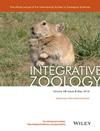雄性蟾蜍的性别识别和配偶选择与相对脑容量呈正相关。
IF 3.7
1区 生物学
Q1 ZOOLOGY
引用次数: 0
摘要
我们的研究结果表明,选择雌性的局灶雄性比选择体型相似的雄性的局灶雄性脑容量相对更大。同样地,不做选择的雄性比同时选择较大和较小雄性的雄性脑容量相对较大。最后,我们发现,与体型较小的雄性相比,与体型较大的雌性紧握在一起的雄性的脑容量相对较大。本文章由计算机程序翻译,如有差异,请以英文原文为准。
Sex Recognition and Mate Choice Are Positively Correlated With Relative Brain Size in Male Bufo andrewsi.
Our results showed that focal males choosing females had relatively larger brain sizes than focal males choosing males with similar body sizes. Likewise, focal males making no choice had relatively larger brain sizes than focal males choosing both larger and smaller males. Finally, we found that focal males clasping larger females had relatively larger brain sizes than focal males clasping smaller males.
求助全文
通过发布文献求助,成功后即可免费获取论文全文。
去求助
来源期刊

Integrative zoology
ZOOLOGY-
CiteScore
6.40
自引率
12.10%
发文量
81
审稿时长
>12 weeks
期刊介绍:
The official journal of the International Society of Zoological Sciences focuses on zoology as an integrative discipline encompassing all aspects of animal life. It presents a broader perspective of many levels of zoological inquiry, both spatial and temporal, and encourages cooperation between zoology and other disciplines including, but not limited to, physics, computer science, social science, ethics, teaching, paleontology, molecular biology, physiology, behavior, ecology and the built environment. It also looks at the animal-human interaction through exploring animal-plant interactions, microbe/pathogen effects and global changes on the environment and human society.
Integrative topics of greatest interest to INZ include:
(1) Animals & climate change
(2) Animals & pollution
(3) Animals & infectious diseases
(4) Animals & biological invasions
(5) Animal-plant interactions
(6) Zoogeography & paleontology
(7) Neurons, genes & behavior
(8) Molecular ecology & evolution
(9) Physiological adaptations
 求助内容:
求助内容: 应助结果提醒方式:
应助结果提醒方式:


